 |
 |
 |
 |
 |
 |
| |
 |
|
 |
 |
 |
  |
  |
 |
 |
 |
 |
|
|
 |
|
 |
 |
 |
BUILDING |
 |
|
 |
|
 |
 |
 |
| |
 |
| 
 |
Fondation Beyeler
|
|
 |
 |
 |
 |
DESIGNER |
 |
|
|
 |
|
 |
 |
 |
| |
 |
|
 |
 |
 |
 |
DESCRIPTION |
 |
|
|
 |
|
 |
 |
 |
| The Fondation Beyeler |
 |
|
 |
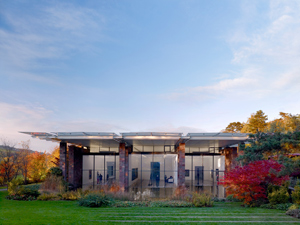 The Fondation Beyeler was officially inaugurated in Riehen on the outskirts of Basel on 18 October 1997, providing Hildy and Ernst Beyeler’s remarkable art collection with a publicly accessible home. The new museum was built by the Genovese architect Renzo Piano, whose work includes the Centre Pompidou in Paris, over a period of around three years. An extension to the museum was officially inaugurated in September 2000. The Fondation Beyeler was officially inaugurated in Riehen on the outskirts of Basel on 18 October 1997, providing Hildy and Ernst Beyeler’s remarkable art collection with a publicly accessible home. The new museum was built by the Genovese architect Renzo Piano, whose work includes the Centre Pompidou in Paris, over a period of around three years. An extension to the museum was officially inaugurated in September 2000.
The building of the museum was financed by a non-profit-making foundation set up by Hildy and Ernst Beyeler in 1982, which also supports the Fondation Beyeler financially. The Riehen authorities provided the site free of charge and the Canton of the City of Basel makes an annual contribution that covers around one-third of the museum’s running costs.
With his tranquil, restrained building, Renzo Piano has created a museum intended “to serve art, and not the other way round.” Clad with red porphyry, it consists of four monumental parallel walls, a glass façade at either end or a winter garden on the west side that looks out over the surrounding countryside. The glass roof suspended over the structure illuminates the whole building with the natural light so desirable for exhibiting works of art. All technical or design details that might distract visitors have been deliberately eliminated from the twenty-two exhibition rooms.
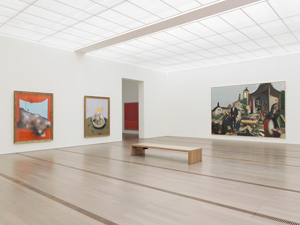 Consisting of around 200 paintings and sculptures by modern masters, the Beyeler Collection was accumulated by Hildy and Ernst Beyeler during more than fifty years as successful gallery owners. The collection’s scope and reputation is constantly being enhanced by the acquisition of major works by artists such as Cézanne, van Gogh and Warhol. In some rooms, selected examples of tribal art from Africa, Alaska and Oceania are displayed side by side with European and American works, creating exciting encounters to be found in virtually no other museum in the world. Consisting of around 200 paintings and sculptures by modern masters, the Beyeler Collection was accumulated by Hildy and Ernst Beyeler during more than fifty years as successful gallery owners. The collection’s scope and reputation is constantly being enhanced by the acquisition of major works by artists such as Cézanne, van Gogh and Warhol. In some rooms, selected examples of tribal art from Africa, Alaska and Oceania are displayed side by side with European and American works, creating exciting encounters to be found in virtually no other museum in the world.
Through temporary exhibitions that occupy around one-third of the total exhibition space, the Fondation Beyeler repeatedly creates links between the permanent collection and contemporary art. Up to four special exhibitions closely associated with the permanent collection’s contents and characters are held every year.
The following exhibitions have been held at the Fondation Beyeler since its inauguration: “Jasper Johns. Loans from the Artist,” “Renzo Piano. Building Workshop,” “Colours–Sounds. Vasily Kandinsky and Arnold Schönberg,” “Roy Lichtenstein,” “The Magic of Trees” with “Wrapped Trees” by Christo & Jeanne-Claude, “Face to Face to Cyberspace,” “Cézanne and Modernism,” “Colour to Light,” “Andy Warhol. Series and singles,” “Mark Rothko,” “Ornament and Abstraction,” “Anselm Kiefer. The Seven Heavenly Palaces 1973–2001,” “Claude Monet ... up to digital Impressionism”, “Ellsworth Kelly. Works 1956–2002”, “EXPRESSIVE!”, “Paul Klee. Fulfillment in the Late Work”, “Mondrian + Malevich at the Center of the Collection”, “Francis Bacon and the Tradition of Art”, “Calder – Miró”, “ArchiSculpture”, “Flower Myth. Vincent van Gogh to Jeff Koons”, “The Surrealist Picasso”, “René Magritte. The Key to Dreams”, “Contemporary Voices: Fondation Beyeler hosts The UBS Art Collection”, “Wolfgang Laib. The Ephemeral is Eternal” and, most recently “Henri Matisse. Figure Color Space”.
All these exhibitions have received considerable international acclaim.
The Fondation Beyeler owes its unique attractiveness to its combination of a superb modern art collection and a fascinating architectural and natural setting, as well as to temporary exhibitions on the highest international level that offer visitors new insights not only into 20th-century art but also into the latest developments in contemporary art. |
|
 |
 |
 |
|
 |
|
| The Architecture |
 |
|
 |
The Fondation Beyeler consists of three parts: the Berower Park, acquired by the Riehen authorities in 1976, the 18th-century Berower Villa, which houses the restaurant and offices, and the museum recently built by Renzo Piano.
In 1991, the Genovese architect Renzo Piano – who was awarded the renowned Pritzker Prize in 1998 – was invited to develop an architectural concept for the Fondation. Piano described the assignment as follows: “A museum should attempt to interpret the quality of the collection and define its relationship with the outside world. This means taking an active, but not an aggressive role.” Two years later following a referendum held in Riehen, permission was given to build the museum. Construction work began the following year and continued until autumn 1997. |
|
 |
 |
 |
|
 |
|
| The Museum Building |
 |
|
 |
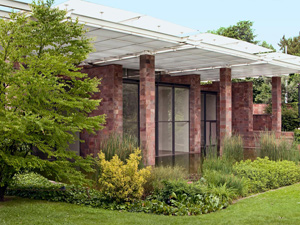 The elongated building covers the whole breadth of the narrow plot of ground situated between a busy main road and a protected area of farmland. It combines two contrasting motifs: long, solid walls and a light, apparently floating glass roof. All the external walls are clad with red porphyry from Patagonia (Argentina). The elongated building covers the whole breadth of the narrow plot of ground situated between a busy main road and a protected area of farmland. It combines two contrasting motifs: long, solid walls and a light, apparently floating glass roof. All the external walls are clad with red porphyry from Patagonia (Argentina).
The building is supported by four 127 metre-long parallel load-bearing walls placed at intervals of about seven metres. The two end façades are made of glass and look out over the park. On the road side, the museum is completed by a windowless wall that protects the building and on the inside of which the Art Shop, cloakroom, toilets, etc. are located. Piano has described this wall as a kind of “backbone” or “formative zone” from which the architecture of the whole building develops. On the opposite wall there is a winter garden with a view of the surrounding countryside.
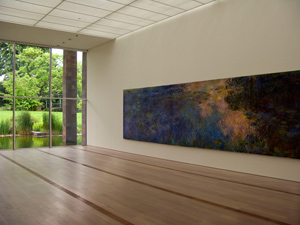 Located between the longitudinal walls, the exhibition rooms dedicated to the permanent collection are arranged in a well-proportioned pattern that can be altered if necessary. The rooms are not organised in any strict linear order, but visitors feel a natural inclination to move in a certain direction. Another distinctive characteristic of the Fondation Beyeler is the absolute serenity of the exhibition rooms, which is unmarred by any technical or design details and is enhanced by the sensitive interplay between the walls, the ceiling and the light-coloured French oak floor. Located between the longitudinal walls, the exhibition rooms dedicated to the permanent collection are arranged in a well-proportioned pattern that can be altered if necessary. The rooms are not organised in any strict linear order, but visitors feel a natural inclination to move in a certain direction. Another distinctive characteristic of the Fondation Beyeler is the absolute serenity of the exhibition rooms, which is unmarred by any technical or design details and is enhanced by the sensitive interplay between the walls, the ceiling and the light-coloured French oak floor.
About one-third of the total exhibition space is reserved for temporary exhibitions that are presented directly beside the permanent collection. A staircase in the adjacent winter garden leads down to the museum’s lower level, where there is a 311 square metres multi-purpose room that can also be used for temporary exhibitions.
A large glass roof lets daylight into the whole building. Unlike conventional top lighting, this roof allows the zenithal daylight to filter into the building’s interior in its natural state instead of homogenising it and making it diffuse and milky. There are also three systems with artificial light sources that illuminate the rooms when there is insufficient light from outside.
With his museum for the Fondation Beyeler, Renzo Piano has created a building of restrained elegance that serves art without being self-effacing. This characteristic is discussed in detail in the book “Renzo Piano–Fondation Beyeler. A Home for Art”, which places the building in the context of international museum architecture. Basel’s international reputation as a centre of fine architecture is considerably enhanced by the Fondation Beyeler. |
|
 |
 |
 |
|
 |
|
| The Extension |
 |
|
 |
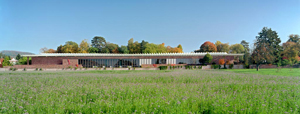 Less than two years after the Fondation Beyeler’s inauguration, the museum was extended by 12 metres (between September 1999 and May 2000). The total exhibition space was increased by 458 square metres to 3,764 square metres, offering more flexibility for the organisation of exhibitions. Additional space was created on the lower level for events, seminars, new media and offices. At the same time, the museum’s grounds were extended to the north so that the building now stands in the centre of them geographically as well as in other respects. Less than two years after the Fondation Beyeler’s inauguration, the museum was extended by 12 metres (between September 1999 and May 2000). The total exhibition space was increased by 458 square metres to 3,764 square metres, offering more flexibility for the organisation of exhibitions. Additional space was created on the lower level for events, seminars, new media and offices. At the same time, the museum’s grounds were extended to the north so that the building now stands in the centre of them geographically as well as in other respects. |
|
 |
 |
 |
|
 |
|
| . |
 |
|
 |
Renzo Piano–Fondation Beyeler. A Home for Art. Edited by the Fondation Beyeler, with essays by Ernst Beyeler, Werner Blaser, Markus Brüderlin, Andrea Compagno, Roman Hollenstein, Renzo Piano and Jochen Wiede.
Birkhäuser–Publishers for Architecture, Basel, Boston and Berlin, 1998; second enlarged edition 2001.
Courtesy of Fondation Beyeler
|
|
 |
 |
 |
 |
 |
 |
 |
MATERIALS |
 |
|
|
 |
|
 |
 |
 |
 |
 |
|
reinforced concrete, stone, metal, glass, cloth Floors:
French white oak, slightly stained and oiled
Outer walls:
Red porphyry (Patagonia/Argentina), glass façades with external blinds
Roof:
White-painted steel construction with a glass roof that can be walked on and around 900 repetitive shed brise-soleil (with a total surface area of 2,685 square metres)
|
|
 |
 |
 |
 |
LOCATION |
 |
|
|
 |
|
 |
 |
 |

|
 |

|
Continent |
|
 |
  Europe |
|
Nation |
|
 |
  Switzerland [Schweiz/Suisse] |
|
Canton |
|
 |
  Basel-City [Basel-Stadt] |
|
Town |
|
 |
  Riehen |
|
Address |
|
 |
  Baselstrasse 101, CH-4125 Riehen / Basel (Villa Berower)
|
|
|
|
 |
|
Telephone |
|
 |
|
Fax |
|
 |
|
Website |
|
 |
|
E-mail |
|
 |
|
 |
 |
 |
 |
MAP |
 |
|
|
 |
|
 |
 |
 |
| |
 |
|
 |
 |
 |
 |
|
TYPOLOGY |
 |
|
|
 |
|
 |
 |
 |
|
|
 |
ARCHITECTURE | Buildings for cultural activities
Art galleries and exhibition areas
Museums and buildings for exhibitions
Art museums
|
LANDSCAPE ARCHITECTURE AND NATURAL ENVIRONMENTS | Landscape architecture
Private gardens
| |
 |
 |
 |
 |
CHRONOLOGY |
 |
|
|
 |
|
 |
 |
 |
Project |
 |
|
 |
| 
 |
1992 - 1994
|
|
Realisation |
 |
|
 |
| 
 |
1994 - 2000 |
|
 |
 |
 |
 |
THE BUILDING IN CINEMA |
 |
|
|
 |
|
 |
 |
 |
| Title |
 |
|
 |
|
| Directed by |
 |
|
 |
|
| Nationality |
 |
|
 |
|
| Year of production |
 |
|
 |
|
| Cast |
 |
|
 |
|
| Building's role |
 |
|
 |
|
 |
 |
 |
 |
 |
 |
 |
BIBILIOGRAPHIC REFERENCES |
 |
|
|
 |
|
 |
 |
 |
|
 |
 Renzo Piano, Fondation Beyeler, Fondazione Renzo Piano, 2009 Renzo Piano, Fondation Beyeler, Fondazione Renzo Piano, 2009 |
|
|
| AA.VV., Renzo Piano. Fondation Beyeler. Una casa per l'arte, Birkhäuser, Basel 2001 |
|
|
| Architectural Guide. Basel 1980-2000, Birkhaüser, Basel 2000, n. 86 |
|
|
| 6th Mies van der Rohe Award for European Architecture, Fundació Mies van der Rohe and ACTAR, Barcelona 1999, pp. 118-121 |
|
|
| Alessandro Rocca, "Oltre la tecnica/Beyond Technique", Lotus international 99, dicembre/december 1998 [Forma e struttura/Form and Structure], pp. 32-51 |
|
|
| "Beyeler Foundation Museum, Riehen, Basel, Switzerland. Renzo Piano Building Workshop", GA Document 55, june 1998, pp. 50-59 |
|
|
Claudia Conforti, "Levigate artificiosità/Polished Artifice", Casabella 656, maggio/may 1998 [Produce of Italy], "Profilo" pp. 62-85
"Museo della Fondazione Beyeler. Riehen, Basilea", Casabella 656, maggio/may 1998 [Produce of Italy], "Profilo" pp. 66-72 (62-85) |
|
|
| James S. Russell, "The Beyeler Museum, by Pritzker Prize winner Renzo Piano, engages in a discreet dialogue between architecture and art", Architectural Record 5/1998, may 1998, pp. 160-169 |
|
|
| Anthony Tischhauser, "Silent light: Piano in Basel", Architecture Today 86, march 1998, pp. 14-16, 19-20 |
|
|
Peter Buchanan, "Piano: responding to place, programme and the present", A+U. Architecture and Urbanism 2/1998, february 1998, pp. 68-125
"Beyeler Foundation museum, Riehen", A+U. Architecture and Urbanism 2/1998, february 1998, pp. 92-103 (68-125) |
|
|
| "Beyeler Foundation/Fundación Beyeler", Renzo Piano. Sustainable architectures/Arquitecturas sostenibles, Editorial Gustavo Gili, "Architecture monograph/Monográfico arquitectura", Barcelona 1998, pp. 24-33 |
|
|
| Markus Brüderlin, "Museo della fondazione Beyeler, Riehen, Basilea/The Beyeler Foundation Museum at Riehen, Basle", Domus 798, novembre/november 1997 [Star System], pp. 54-60 |
|
|
| Renzo Piano, Giornale di bordo, Passigli Editori, Firenze 1997, pp. 220-223 |
|
|
| Mercedes Daguerre, Birkhäuser Architectural Guide Switzerland 20th Century, Birkhäuser, Basel 1997, p. 382 (381-385) |
|
|
| Alessandro Rocca, "Renzo Piano. Noumea, Paris", Lotus international 83, novembre/november 1994 [Architettura italiana allo specchio/Italian Architecture in the Mirror], p. 44 (42-55) |
|
|
| "Renzo Piano. Museo Beyeler a Riehen, Basilea", Domus Dossier 2, 1994 [Musei], pp. 30-33 |
|
 |
 |
 |
 |
 |
 |
 |
ADDITIONS AND DIGRESSIONS |
 |
|
|
 |
|
 |
 |
 |
| |
 |
Opening press conference Fondation Beyeler
Speech of Ernst Beyeler
|
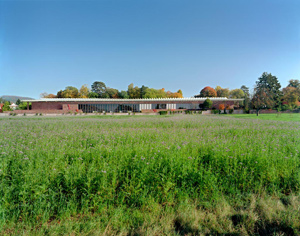 Many years ago, I looked out of the window of the old Berower House onto the park and thought how nice it would be to show our pictures here; but the house was too small, I reflected, and our pictures were going to the Basel Museum one day anyway. Now, however, my dream has come true, and some-thing in the nature of a summer house has emerged, a synthesis between the two Basel Museums - with which we have excellent contact. We look upon this as a very special building, and I should like to express my thanks to the architect Renzo Piano and his Paris-based team with Bernard Plattner and Loik Couton for their patient and untiring work, and to Burkhardt and Partners, Ove Arup and Partners in London, Cyrill Burger in Basel, the different companies involved and our many helpers who were in-strumental in the achievement of this outstanding work. And of course to the long-standing collabora-tors of the gallery and museum including the curator Markus Brüderlin and the administrator Beat Pri-vat, and the Roth and Kuster team who were responsible for the museum's interior. It was fascinating to watch the thousands of site workers, craftsmen, technicians, specialists, engineers, gardeners and ar-chitects at work day after day, and later on to work with the restorers, framers, photographers and prin-ters along with the staff of the gallery and the museum, in particular on the catalogue of the permanent collection which was produced by Jürgen Tesch from the Prestel Publishing company under particularly difficult circumstances caused by the fact that works were constantly being added or withdrawn from the collection up till the last moment. I am also grateful to all our friends who have supported us in word and deed, and above to all my wife who simply said: "Go ahead with the museum!" Many years ago, I looked out of the window of the old Berower House onto the park and thought how nice it would be to show our pictures here; but the house was too small, I reflected, and our pictures were going to the Basel Museum one day anyway. Now, however, my dream has come true, and some-thing in the nature of a summer house has emerged, a synthesis between the two Basel Museums - with which we have excellent contact. We look upon this as a very special building, and I should like to express my thanks to the architect Renzo Piano and his Paris-based team with Bernard Plattner and Loik Couton for their patient and untiring work, and to Burkhardt and Partners, Ove Arup and Partners in London, Cyrill Burger in Basel, the different companies involved and our many helpers who were in-strumental in the achievement of this outstanding work. And of course to the long-standing collabora-tors of the gallery and museum including the curator Markus Brüderlin and the administrator Beat Pri-vat, and the Roth and Kuster team who were responsible for the museum's interior. It was fascinating to watch the thousands of site workers, craftsmen, technicians, specialists, engineers, gardeners and ar-chitects at work day after day, and later on to work with the restorers, framers, photographers and prin-ters along with the staff of the gallery and the museum, in particular on the catalogue of the permanent collection which was produced by Jürgen Tesch from the Prestel Publishing company under particularly difficult circumstances caused by the fact that works were constantly being added or withdrawn from the collection up till the last moment. I am also grateful to all our friends who have supported us in word and deed, and above to all my wife who simply said: "Go ahead with the museum!"
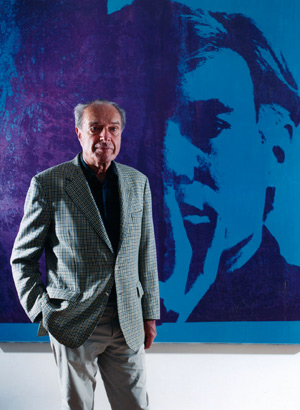 Our thanks also go to the authorities of Riehen and Basel who backed the project from the very begin-ning and always lent an attentive ear to our requests and supported us with a substantial contribution to the running costs. My thanks are also due to the people of Riehen who voted in favour of the project in a memorable ballot. Our thanks also go to the authorities of Riehen and Basel who backed the project from the very begin-ning and always lent an attentive ear to our requests and supported us with a substantial contribution to the running costs. My thanks are also due to the people of Riehen who voted in favour of the project in a memorable ballot.
I should also like to take this opportunity of thanking the collectors, museum directors and colleagues whose confidence, ideas, criticism and purchases have happily served both their own interests and tho-se of our museum. I have received valuable advice from Bill Rubin over many years in the dialogue which he mentions in his foreword to this catalogue.
Our motivation can be described in a few words. Firstly, we have always been deeply moved by great works of art, and their impact on us is such that we are often loathe to part with them; and secondly, we have a need to share these works with others and pass on the profit they bring. Also, and above all, we want to pay homage to the great artists of our time, a time which will probably go down as one of the outstanding periods in the history of art. Our credo is also connected with our desire to express our thanks for the privilege of knowing many of these artists personally and of having been inspired by their genius and skill. I should like to thank you all for coming from far and wide to be present at this act of homage to the painters, sculptors and architects. I have always perceived works of art as parables of creation - "analogous to nature" as Cézanne once said -, as an expression of joie de vivre, which is also the title of our current gallery exhibition which we plundered at the last moment in order to enrich the museum's exhibition. We have always been our own best customers - although this does not mean that we have not sold a great many of our finest works to our clients, a fact which may one day be proved by an exhibition of the paintings now in museums and collections in many parts of the world which are on a par with this collection.
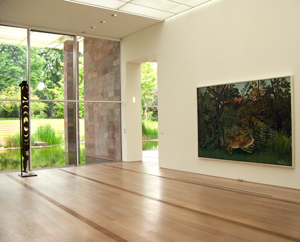 In his foreword to the catalogue, Professor Gottfried Boehm writes that our collection consists of "pro-ven works". True; but it is our love for the works that is the key to our collection, and we hope that this comes across to the viewer. We are fascinated, too, by the art of Africa, Oceania and Alaska, highly imaginative and expressive works which are thoroughly on a level with great western art and which ha-ve an aura of irresistible magic. In his foreword to the catalogue, Professor Gottfried Boehm writes that our collection consists of "pro-ven works". True; but it is our love for the works that is the key to our collection, and we hope that this comes across to the viewer. We are fascinated, too, by the art of Africa, Oceania and Alaska, highly imaginative and expressive works which are thoroughly on a level with great western art and which ha-ve an aura of irresistible magic.
An art collection, however fine, must remain in touch with life. With our changing exhibitions, we hope to make a dynamic contribution the contemporary art scene, and whenever possible to create a connec-tion between art and life, with special reference to environmental problems which have always been a special concern of the Foundation. Art cannot exist with people - although today it could also be said, unfortunately, that art would be able to survive more easily without people. We are grateful to Jasper Johns for allowing us to show his magnificent collection of paintings and drawings which continues the tradition of the great 20th century masters and which was originally intended for his own private plea-sure. In this context, we should like to thank Kirk Varnedoe and Jennifer Russel from the New York Museum of Modern Art, Sarah Taggart from the Jasper Johns Studio, and Verena Formanek from the Beyeler Foundation. We also wish to express our gratitude for a small number of permanent loans which round off our collection and which we hope will subsequently become an integral part of it.
Like the great masters, the museum's architect Renzo Piano was motivated by his constant concern with strong expression and perfection. His aim was to provide the works of art with a worthy framework, as it were with an allegorical structure of walls clad with solid, 120-year-old, dark porphyry and a fragile suspended glass roof. The lively and empathetic dialogue between the architect and ourselves made the long construction period a dynamic experience which started out "piano, piano" (gently, gently) and evolved into a Grand Piano. We should also like to thank him for the exhibition of his projects which, with the help of Alberto Giordano, Giorgio Bianchi and all the other employees of the Renzo Piano Buil-ding Workshop, have been arranged to form an interesting and instructive display which bears witness to the wonderful variety of his work to date. This architect, who is constantly in search of new solutions and materials, may justifiably be regarded as a worthy successor to his fellow Christopher Columbus.
My wife and I would like to express our sincere thanks to you all, to everyone who has played a part in this venture to the glory of art.
Courtesy by Fondation Beyeler |
|
 |
 |
 |
 |
 |
 |
 |
CLIENT |
 |
|
|
 |
|
 |
 |
 |
| |
 |
| Beyeler Foundation (Ernst Beyeler, F. Vischer, U. Albrecht) |
|
 |
 |
 |
 |
AMOUNT |
 |
|
|
 |
|
 |
 |
 |
| |
 |
SF. 66.000.000
(1° building SF. 55.000.000, extension SF. 11.000.000) |
|
 |
 |
 |
 |
DIMENSIONAL
DATA |
 |
|
|
 |
|
 |
 |
 |
| Dimensions |
 |
|
 |
|
| Surface |
 |
|
 |
1° building sq.m. 5.490
extension sq.m. 735
total sq.m. 6.225
exhibition area
1° building sq.m. 3.306
extension sq.m. 458
total sq.m. 3.764 |
|
| Volume |
 |
|
 |
1° building m³ 42.800
extension m³ 3.650
total m³ 46.450 |
|
 |
 |
 |
 |
STRUCTURES |
 |
|
|
 |
|
 |
 |
 |
| |
 |
| Ove Arup & Partners (T. Barker, J. Wernick, A. Sedgwick) |
|
 |
 |
 |
 |
LANDSCAPE DESIGN |
 |
|
|
 |
|
 |
 |
 |
| |
 |
Schönholzer + Stauffer GmbH, Riehen
Jochen Wiede, Basel |
|
 |
 |
 |
 |
STAFF |
 |
|
|
 |
|
 |
 |
 |
Project  |
 |
| Renzo Piano Building Workshop, Paris |
|
|
 |
|
|
 |
|
Project leader |
 |
|
Associate architect |
 |
| J. Burckhardt + Partner AG, Basel |
|
Project architect |
 |
|
Principal-in-charge |
 |
|
Consultant |
 |
Cyrill Burger + Partner AG; Bogenschüts AG
Jakob Forrer; Elektrizitäts AG Basel
Tschudin AG
Creaning Management AG
Hiag Parkett |
|
Collaborators |
 |
| William Mathews, Ronnie Self, Pascal Hendier, William Vassal, Lukas Epprecht, Jan Berger, Eva Belik |
|
Plastic models, rendering, visualization |
 |
| Jean Philippe Allain, Christophe Colson |
|
Construction supervision |
 |
| C. Burger + Partner AG, Basel |
|
 |
 |
 |
 |
ANNOTATIONS |
 |
|
|
 |
|
 |
 |
 |
| |
 |
First plans submitted by Renzo Piano in April 1992
Referendum on 5/6 June 1993 the population of Riehen approved the project by a large majority
Inauguration 18 October 1997
Extension started: September 1999
Extension completed: September 2000 |
|
 |
 |
 |
 |
RELATED PROJECTS |
 |
|
|
 |
|
 |
 |
 |
| |
 |
|
 |
 |
 |
 |
CREDITS |
 |
|
|
 |
|
 |
 |
 |
| |
 |
Photos © Niggi Bräuning | Todd Eberle | Serge Hasenböhler | Mark Niedermann
Courtesy of Fondation Beyeler, Switzerland 2010
|
|
 |
  |
 |
|
|